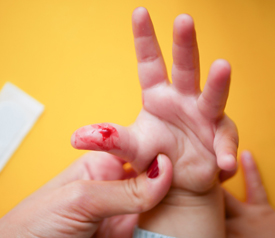
Wounds are a common occurrence for everyone throughout their lives. From light scrapes to serious punctures and everything in between, it’s likely that everyone will eventually need to perform wound care on themselves, likely several times in their lives.
A wound occurs when the skin is seriously damaged and may include damage to the underlying tissue, even as deep as the muscle. Most wounds will heal over time after basic wound care practices are carried out. Chronic wounds require special attention and typically will need regular care for weeks, months, or even years.
It’s important to understand the basic principles of wound care to help avoid serious problems. With proper care, a wound can repair in full, leaving a small scar or no scar at all.
Here are 8 steps to effective wound care:
1) Wash your hands before you begin care
Before any wound care is administered to your own wound or another’s wound, washing your hands with soap and water is essential. This helps lower the chances of bacteria or debris entering and infecting the wound.
Using an antibacterial soap is always a good idea. If available, a saline solution can also be used for cleaning the hands. Antibacterial hand sanitizer can also provide further protection from infection of the wound.
2) Stop the wound from bleeding
In some cases, a wound may not be bleeding much at all, but may simply look red or have a very small amount of blood on the surface of the skin. In other instances, a flow of blood may be present. In these cases, the flow must be stopped before any further care can be administered.
Applying a clean towel is the best way to slow and stop the bleeding. Apply pressure to the wound for a minute or two and carefully remove the towel to see if the flow of blood has stopped. If not, applying pressure for another minute or two may give the wound time to heal on the surface and stop the bleeding.
3) Wash and clean the wound thoroughly
Even though the wound is still very sensitive, it’s important to wash the affected area with soap and water. Very carefully apply soap and water to the wound and rinse the area in full. Make sure to not rub the wound hard at all, as the bleeding could begin again.
Antibacterial soap or saline solution can be used for cleaning the wound. Both will help kill and remove harmful bacteria that could otherwise lead to an infection. Pat the skin dry very carefully to help keep the skin as intact as possible.
4) Apply antibiotic ointment
If available, apply antibiotic ointment over the wound opening. This not only kills bacteria that could try to get into the wound but also provides a protective barrier over the skin, helping the skin to begin the healing process. Carefully apply the ointment by patting it onto the wound with a towel or bandage.
5) Cover the wound with a bandage
Using a fresh bandage made of gauze or another material, carefully cover the wound completely. Wrap the bandage around as many times as needed to apply a bit of pressure and ensure that it stays steady. Use Hy-Tape to hold the bandage in place, taping the bandage on all sides. This will help ensure that the bandage doesn’t shift with your movements or come loose enough to scrape the skin open again.
6) Change the bandage as needed
Every type of wound will require a different amount of time between bandage changes. Typically, a bandage change every day will be helpful for the wound to heal.
Just as with the first bandage application, be sure to wash your hands thoroughly before you begin. Carefully remove and throw away the old bandage and gently wash and pat dry the wound. Apply a new sanitary gauze bandage to the affected area and secure it in place with Hy-Tape once again.
7) Monitor the wound’s healing progress
With every bandage change, it’s important to look at the wound and determine how it’s healing. Notice if the skin is closing up, if redness is dissipating, if the liquid discharge is lessening with each day, and if pain levels are lessening. Every wound will heal differently but most should show signs of improvement every day.
8) Visit a doctor
Even with proper wound care, it’s important to see a doctor after a wound has formed. A professional will be able to discuss what happened and determine if the healing process is going properly. Make sure to consult a professional to ensure that your wound is healing as it should and that no permanent damage is left unchecked.
How Hy-Tape helps speed the wound healing process
Hy-Tape is known for its many benefits for wound care. It’s a great option for securing a wound dressing for several reasons:
- Hy-Tape offers a secure hold. The tape is designed to stick well to the skin and not move until peeled away, securely keeping a wound dressing in place.
- Hy-Tape peels away easily. When it’s time for a dressing change, Hy-Tape can be easily removed without irritating the skin.
- Hy-Tape includes zinc oxide. This feature protects the skin while Hy-Tape is in contact with the patient, helping to ensure that their skin doesn’t take on further damage due to the tape.
- Hy-Tape is waterproof. Wounds tend to produce a liquid discharge and blood as they heal. Water and other liquids must stay away from the wound as it heals, too. A waterproof dressing tape protects the wound both inside and out.
No matter the type or size of the wound, Hy-Tape is a great option for protecting the wound dressing and skin. Learn more about how Hy-Tape can improve wound care for yourself or your patients by contacting us here.

